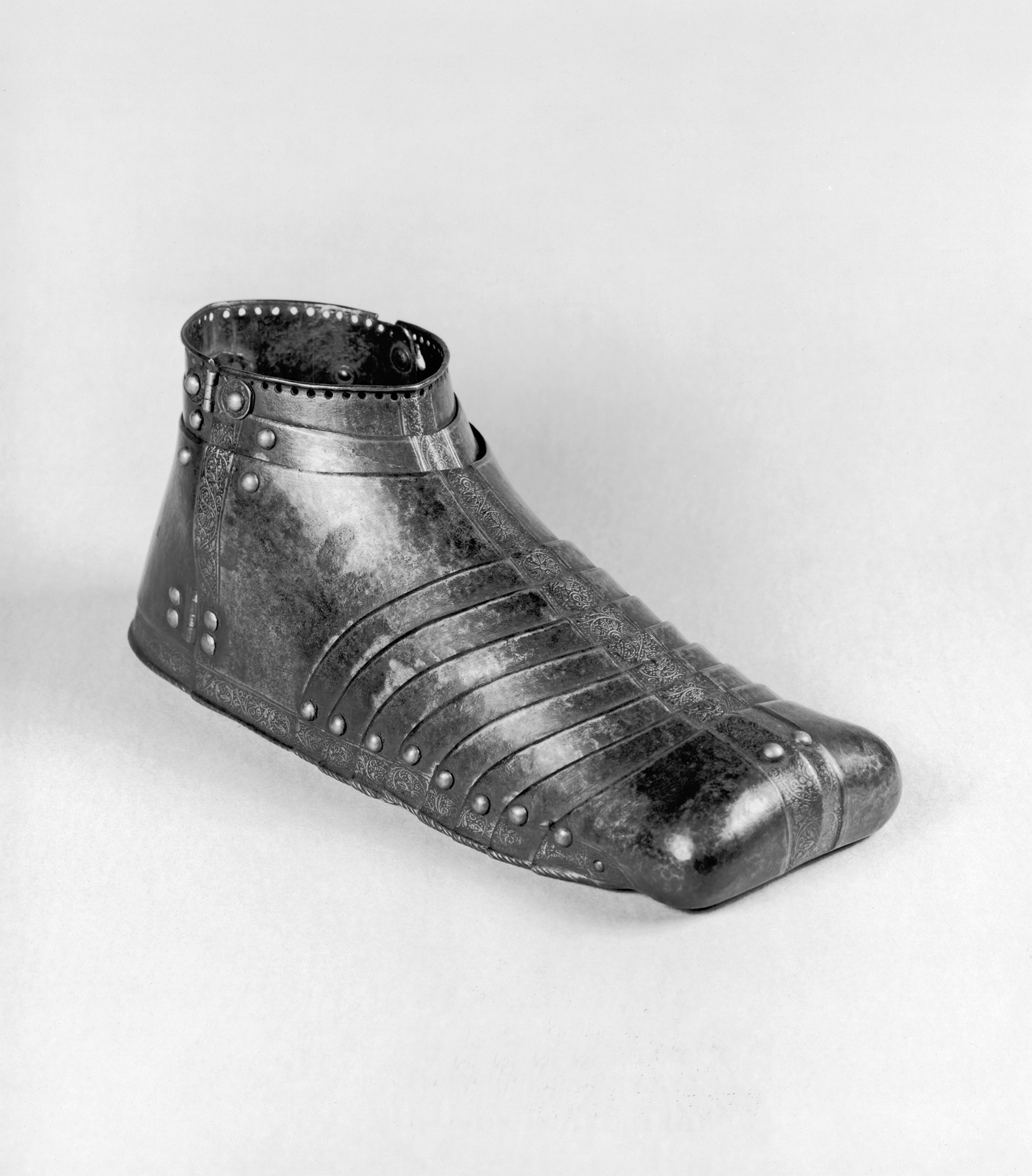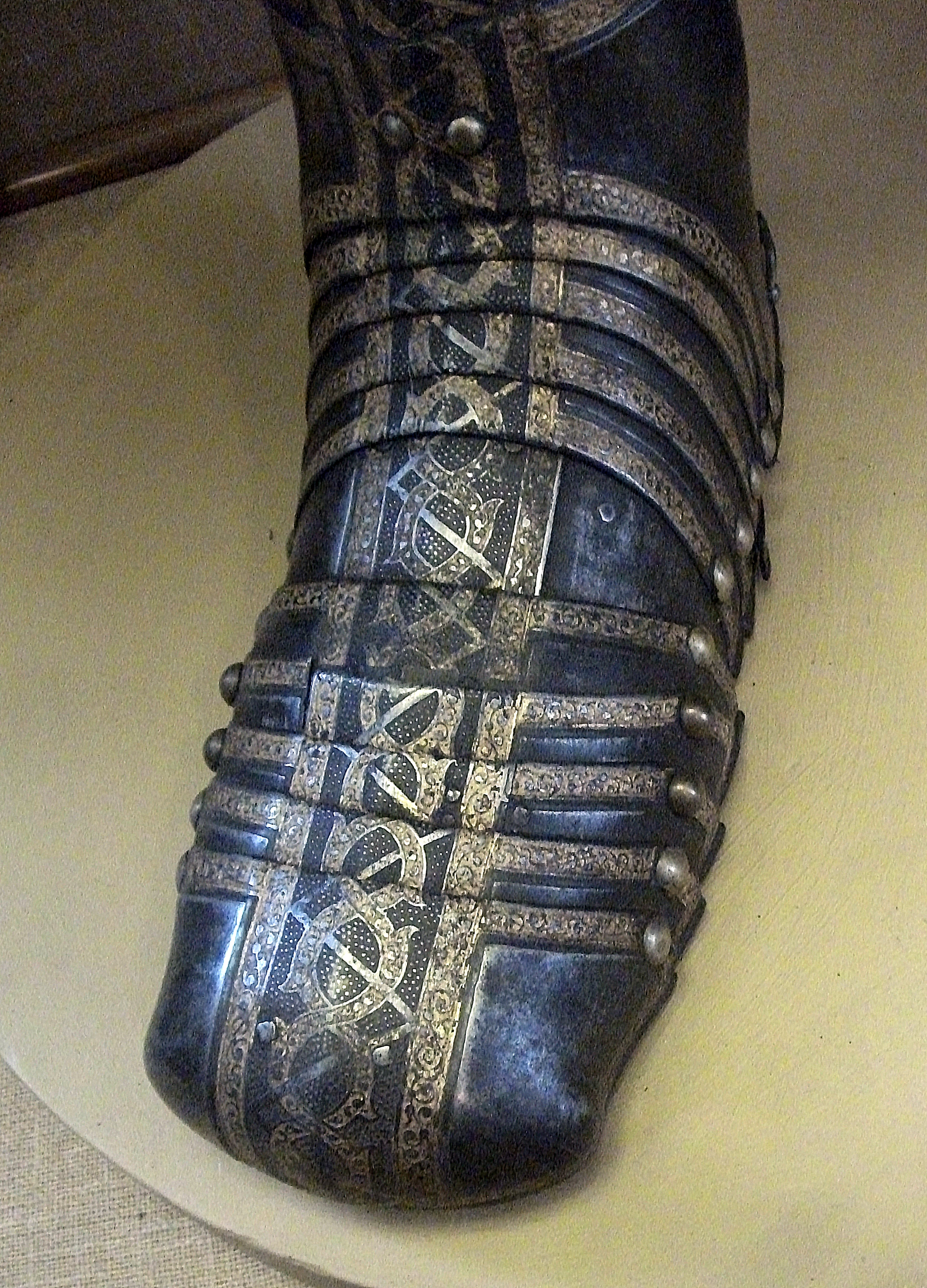Sabaton – Elbriot 2016 02 on:
[Wikipedia]
[Google]
[Amazon]

 A sabaton or solleret is part of a
A sabaton or solleret is part of a
File:HJRK A 62 - Armoured shoes of Maximilian I, 1485.jpg, Sabatons of

knight
A knight is a person granted an honorary title of knighthood by a head of state (including the Pope) or representative for service to the monarch, the church or the country, especially in a military capacity. Knighthood finds origins in the Gr ...
's body armor
Body armor, also known as body armour, personal armor or armour, or a suit or coat of armor, is protective clothing designed to absorb or deflect physical attacks. Historically used to protect military personnel, today it is also used by variou ...
that covers the foot.
History
Fourteenth and fifteenth century sabatons typically end in a tapered point well past the actual toes of the wearer's foot, following fashionable shoe shapes of the fourteenth century. Sabatons of the first half of sixteenth century end at the tip of the toe and may be wider than the actual foot. They were the first piece of armour to be put on, and were made of riveted iron plates called '' lames''. These plates generally covered only the top of the foot. Some sources maintain that the broad-toed variant is the true sabaton, whereas the earlier versions should be referred to as a solleret. At least in theory, French princes and dukes were allowed to have toes of Gothic sabatons long, lords (barons and higher) 2 feet long and gentry only long.Fred & Liliane Funcken, ''Le Costume, l'Armure et les Armes au Temps de la Chevalerie'', "2: Le siècle de la Renaissance (2)" (in French) The sabaton was not commonly used by knights or men at arms fighting on foot. Instead, many would simply wear leather shoes or boots. Heavy or pointy metal footwear would severely hinder movement and mobility on the ground, particularly under wet or muddy conditions. Attacks against the feet are not common in dismounted combat, as a strike to an enemy's foot would typically put the attacker in a very awkward and vulnerable position. Conversely, a mounted knight's feet would be at perfect height for strikes from dismounted soldiers, and so sabatons or other foot armour would be vital when riding into battle. An earlier solution was for the mail of thechausses
Chausses (; ) were a Medieval term for leggings, which was also used for leg armour; routinely made of mail and referred to as mail chausses. They generally extended well-above the knee, covering most of the leg. Mail Chausses were the standar ...
to completely cover the foot, but later the mail terminated at the ankle, either overlapping the outside of the sabaton or extending beneath it. (Chapter 9)
The effigy of Richard Beauchamp, 13th Earl of Warwick
Richard Beauchamp, 13th Earl of Warwick (25 or 28 January 138230 April 1439) was an English medieval nobleman and military commander.
Early life
Beauchamp was born at Salwarpe CourtRichard Gough, ''Description of the Beauchamp chapel, adjoin ...
in the Collegiate Church of St Mary, Warwick
The Collegiate Church of St Mary is a Church of England parish church in Warwick, Warwickshire, England. It is in the centre of the town just east of the market place. It is grade I listed, and a member of the Major Churches Network.
The churc ...
, shows how 15th century Italian-style sabatons would have been worn. These consist of a toe cap, four articulated lames, a foot plate and ankle plate, and a hinged heel cap, joined with buckled straps. Although the spur
A spur is a metal tool designed to be worn in pairs on the heels of riding boots for the purpose of directing a horse or other animal to move forward or laterally while riding. It is usually used to refine the riding aids (commands) and to back ...
s are missing from the effigy, remains of rivet holes and staples may represent the way that the spurs would have been directly attached to the heel cap of the sabaton, rather than being strapped on afterwards.
Other uses
"Sabaton" is also the name of a type of broad-toedFlemish
Flemish (''Vlaams'') is a Low Franconian dialect cluster of the Dutch language. It is sometimes referred to as Flemish Dutch (), Belgian Dutch ( ), or Southern Dutch (). Flemish is native to Flanders, a historical region in northern Belgium; ...
shoe, popular in the Late Middle Ages.
Sabaton
A sabaton or solleret is part of a knight's body armor that covers the foot.
History
Fourteenth and fifteenth century sabatons typically end in a tapered point well past the actual toes of the wearer's foot, following fashionable shoe shapes o ...
is the name of a Swedish heavy metal band who write songs based on military history.
Emperor Maximilian I
Maximilian I (22 March 1459 – 12 January 1519) was King of the Romans from 1486 and Holy Roman Emperor from 1508 until his death. He was never crowned by the pope, as the journey to Rome was blocked by the Venetians. He proclaimed himself E ...
, c. 1485
Image:Sabatons evolution by Wendelin Boeheim.jpg, Sabatons' shape evolution by Wendelin Boeheim:
File:Plate sabatons.png, Sabatons with tapered points (called ''à la poulaine'' or Crakow
Crakows or crackowes were a style of shoes with extremely long toes very popular 1400–1500 in European fashion, in 15th century Europe. They were so named because the style was thought to have originated in Kraków, the then capital of Poland ...
s)
File:Richard de Beauchamp effigy Warwick Church.jpg, Gilded bronze effigy at Warwick
Warwick ( ) is a market town, civil parish and the county town of Warwickshire in the Warwick District in England, adjacent to the River Avon. It is south of Coventry, and south-east of Birmingham. It is adjoined with Leamington Spa and Whi ...
, England, of Richard Beauchamp, 13th Earl of Warwick
Richard Beauchamp, 13th Earl of Warwick (25 or 28 January 138230 April 1439) was an English medieval nobleman and military commander.
Early life
Beauchamp was born at Salwarpe CourtRichard Gough, ''Description of the Beauchamp chapel, adjoin ...
who died in 1439, showing the underside of his sabatons.
References
{{Historical clothing Historical footwear Medieval armour Western plate armour